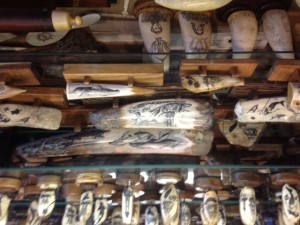
Context:
I was perusing the shops in downtown Lahaina, HI, when I wandered in to a Scrimshaw shop. Curious, I asked the shopkeeper, who had worked at the shop for more than 20 years, about the art.
Interview:
Me: So what is scrimshaw, and where did it begin?
Informant: Scrimshaw is carved and dyed ivory – usually whale teeth and bone. It is New England whalers that scrimshaw is usually attributed to. It is a whaling art that the New England whalers started doing in the late 1700’s early 1800’s when they were out at sea. They were bored, they were uh, they wanted to make gifts for their family members back home, so the teeth and the bone were the leftovers from the whaling industry – the whales were hunted for their fat, their blubber mainly, which was used for, among other things, lamp oil. The bones and the teeth were leftovers, unneeded. And so, the whalers started carving them. The thing about ivories and bone, is that it is one of the oldest mediums that man has worked in general, you know, you get stuff that is carved out of woolly mammoth tusk. Though, so what they specifically attribute to scrimshaw is work such as what is done on sperm whales’ teeth. [See picture for an example of scrimshaw]. And it’s actually an engraving process, where the artwork is hand-engraved into the ivory, which is first polished. Then they take a sharp tool and engrave the design. And then they rub ink into it.
Me: Okay. And I noticed that most of the pieces here are nautical themed. Was that the norm for scrimshaw?
Informant: Yes. It was more often than not nautical themed, or, when you look at antique pieces it was often of things that reminded the whalers of home.
Me: Now, I know that Lahaina was once a whaler’s village, and by the fact that there is a scrimshaw store here, I would assume that when whalers had come here they brought the practice with them?
Informant: Yes. How Hawaii comes into play, is that when the whalers started whaling in the Pacific, Lahaina became the whaling capital of the Pacific because we are a natural three-sided port. So they had safe mooring out here by the road stead, the Lahaina road stead. And uh, they didn’t really whale in Hawaii, the whalers just wintered here. Where the actually whaled was around Alaska.
Me: Okay. That makes some sense. Follow the migration patterns.
Informant: Yes. And because of the ice floes, they would be up around Alaska for much of the year, as all the ships were wooden hulled. So they would sail back down to Lahaina, because back in that era, when they sailed into the Pacific they would have to sail all around the southern end of South America and back up. So it took them months to get into the Pacific and so they didn’t want to try and get back to New England every year.
Me: Makes sense.
Informant: Yes, thus Lahaina became the home base, if you will, for the Pacific whaling industry. So most of the whaling vessels around Hawaii were at sea for around 2-5 years. Some of them might have been inspired by the tattooing, the Hawaiian/Polynesian tattooing they saw. But, scrimshaw as an art was not inspired by the Polynesians, as they did not work bone and ivory in that way.
Me: Awesome. So who would the whalers give these carved and dyed ivory pieces to? And do any of the pieces tell stories or have stories about them?
Informant: The whalers would often give these to people back home. Sometimes, when you see the antiques, they will often be documents of the whaling voyage, of things they saw along the way, or sometimes, women were a popular subject matter.
Me: Yeah, I’ll bet.
Informant: Yes, and so there was a small genre of pornographic scrimshaw, but that was more rare. It was more often with those that they would take pictures from magazines or similar things and essentially copy such pictures onto the teeth/bones. As most, if not all, of them did not have any art training, you know, most of them were illiterate whalers just thinking about their family. So most of the scrimshaw pieces do tell of some kind of event or something similar. So I hope that is what you are looking for.
Me: Yeah, this is great. Thanks a lot.
Informant: You’re very welcome.
Analysis:
Carving ivory, as the informant said, is one of the oldest known practices of mankind. Carved mammoth tusks and bone have been found at prehistoric sites all over Europe. Ivory was most likely used because it is so malleable, and an easy medium to carve or engrave. Scrimshaw, in particular, is probably the best-known example of colonial American folk art. It was created and performed by people who were bored, had no training in art, in engraving or carving or even drawing. Whalers were often illiterate, or at the most slightly educated. They simply put to use the tools and the materials they had on the ship to commemorate a voyage or event on a voyage. Furthermore, with the demise of the whaling industry, the only material now used for making modern scrimshaw is fossilized bone and ivory, which is rather rarer and more expensive to acquire. So, though it began as a true folk art, it is now mostly made by professional artists who can afford the raw materials used as the medium.

